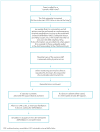ASSESSMENT OF THE QUALITY OF PEDIATRIC CARDIOPULMONARY RESUSCITATION USING THE IN SITU MOCK CODE TOOL
- PMID: 31939509
- PMCID: PMC6958535
- DOI: 10.1590/1984-0462/2020/38/2018173
ASSESSMENT OF THE QUALITY OF PEDIATRIC CARDIOPULMONARY RESUSCITATION USING THE IN SITU MOCK CODE TOOL
Abstract
Objective: To evaluate the quality of individual and team care for cardiac arrest in a pediatric hospital using clinical surprise simulation (in situ mock code).
Methods: We conducted an observational study with a sample of the hospital staff. Clinical simulations of cardiorespiratory arrest were performed in several sectors and work shifts. The mock code occurred in vacant beds of the sector without previous notification to the teams on call. One researcher conducted all mock codes and another evaluated individual and team attendance through a questionnaire contemplating recommendation for adequate cardiopulmonary resuscitation, based on the Pediatric Advanced Life Support (PALS) guidelines. At the end of the simulations, the research team provided a debriefing to the team tested.
Results: Fifteen in situ mock code were performed with 56 nursing professionals (including nurses, nursing residents and technicians) and 11 physicians (including two pediatric residents and four residents of pediatric subspecialties). The evaluation showed that 46.7% of the professionals identified cardiac arrest checking for responsiveness (26.7%) and pulse (46.7%); 91.6% requested cardiac monitoring and venous access. In one case (8.3%) the cardiac compression technique was correct in depth and frequency, while 50% performed cardiopulmonary resuscitation correctly regarding the proportion of compressions and ventilation. According to PALS guidelines, the teams had a good performance in the work dynamics.
Conclusions: There was low adherence to the PALS guidelines during cardiac arrest simulations. The quality of cardiopulmonary resuscitation should be improved in many points. We suggest periodical clinical simulations in pediatric services to improve cardiopulmonary resuscitation performance.
Objetivo:: Avaliar a qualidade do atendimento individual e de equipe à parada cardiorrespiratória (PCR) em hospital pediátrico, utilizando a ferramenta de simulação clínica surpresa (in situ mock code).
Métodos:: Estudo observacional transversal com profissionais de saúde. Foram realizadas simulações clínicas de PCR em diversos setores, em turnos variados, em leito vago do setor sem notificação prévia às equipes de plantão. Um pesquisador conduziu todos os mock code e outro avaliou o atendimento individual e de equipe por meio de questionário contendo recomendações para adequada ressuscitação cardiopulmonar baseadas no protocolo do Suporte Avançado de Vida em Pediatria (PALS). Ao término das simulações, realizou-se debriefing com a equipe testada.
Resultados:: Foram realizados 15 in situ mock code e incluídos 56 profissionais de enfermagem (entre enfermeiros, residentes em enfermagem e técnicos) e 11 médicos (sendo dois residentes em pediatria e quatro pediatras residentes em subespecialidade pediátrica). A avaliação mostrou que profissionais identificaram a PCR checando responsividade (26,7%) e pulso (46,7%); 91,6% solicitaram monitorização cardíaca e acesso venoso. Em um caso (8,3%), a técnica de compressão cardíaca foi correta em profundidade e frequência, enquanto 50% executaram a ressuscitação cardiopulmonar corretamente na proporção de compressão e ventilação. As equipes apresentaram bom desempenho na dinâmica de trabalho, segundo variáveis recomendadas pelo PALS.
Conclusões:: Houve baixa adesão ao protocolo do PALS durante simulações de PCR, observando-se que a qualidade da ressuscitação cardiopulmonar oferecida pode melhorar em muitos pontos. Sugere-se que, em locais de assistência a pacientes pediátricos, sejam realizados treinamentos com simulações clínicas periódicas para melhor atendimento à PCR pediátrica.
Conflict of interest statement
The authors declare no conflict of interests.
References
-
- Neumar RW, Shuster M, Callaway CW, Gent LM, Atkins DL, Bhanji F, et al. Part 1: Executive summary: 2015 American Heart Association Guidelines update for cardiopulmonary resuscitation and emergency cardiovascular care. Circulation. 2015;132(2):S315–S367. doi: 10.1161/CIR.0000000000000252. (Suppl. ) - DOI - PubMed
Publication types
MeSH terms
LinkOut - more resources
Full Text Sources
Medical
Miscellaneous


